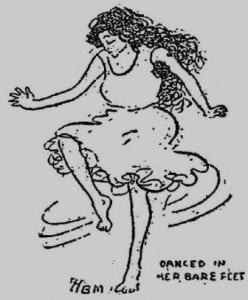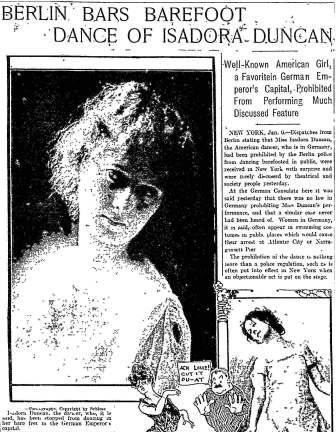Freedom of Movement: The Shocking Life of Isadora Duncan
Isadora Duncan (May 27, 1877 - September 14, 1927). Image from America's Historical Newspapers
Isadora Duncan was dance-struck as a young child in San Francisco. By the time she was six, she was teaching neighborhood children how to move like ocean waves. The strict rules of ballet and conventions of the music hall never held her interest. Indeed, throughout her life as a dancer and teacher, she rebelled against the forms and costumes of traditional dance, preferring movements based on nature and emotion. In 1895, still a teenager, she moved to Chicago and joined the Augustin Daly Company, touring from the Midwest to New York to London. While in London, she also danced solo performances at society events.
New York Journal (April 2, 1898). Click to enlarge.
Upon her return to New York, she left the Daly Company for private performances in the homes of patrons. For these dances, set to poetry recitations by her sister Elizabeth, she wore diaphanous, flowing costumes that permitted free movement and also brought her notoriety. Duncan’s private performances received little notice in the press. Discouraged and disappointed with her American audiences, she returned to London in 1898 to resume performing in the drawing rooms of the rich. There she met artists and critics who introduced her to the figures in classical Greek statuary that inspired her subsequent work.
The Daily Picayune (July 21, 1901). Click to enlarge.
As Duncan’s popularity grew, she was able to afford studio space in which she could create larger works for the stage set to music by Chopin and Beethoven. Loie Fuller, a pathbreaking dancer and lighting designer, took Duncan on tour throughout Europe, where Isadora’s work blossomed further.
The Philadelphia Inquirer (March 1, 1903). Click to enlarge.
Duncan’s diaphanous, corset-less dance costumes were one example of her avant-garde approach. They were light, loose, flowing, revealing the body’s form. She also took to dancing in bare feet, rejecting the unnatural positions required by ballet shoes. Authorities often looked on this attire with dismay and disapproval. As an emancipated woman who flouted conventional morality, Duncan was famous for her private life as well as her dancing. Her liaisons with theatrical set designer Gordon Craig and sewing-machine heir Paris Singer increased her notoriety. She bore a child with each, out of wedlock, long before the term feminist was coined.
Fort Worth Telegram (June 8, 1903). Click to enlarge.
The Philadelphia Inquirer (Jan. 7, 1906). Click to enlarge.
The Sunday Oregonian (Aug. 9, 1942). Click to enlarge.
For all her fame and success, her life was not free of tragedy. Her children died at the ages of six and three when the car they were riding in with their nurse plunged into the River Seine in a freak accident.
The Macon Daily Telegraph (April 20, 1913). Click to enlarge.
Isadora spent most of her life in Europe, attracting curious and enthusiastic audiences wherever she went. She sought to perform and instruct.
Springfield Daily Republican (June 25, 1905). Click to enlarge.
Duncan’s performances and personality received both great praise and severe criticism.
The Seattle Daily Times (Aug. 15, 1908). Click to enlarge.
Teaching continued to be her calling. She spent much of her time seeking support for her dance schools, one of which was in Grunewald, a suburb of Berlin.
Cleveland Plain Dealer (Oct. 10, 1909). Click to enlarge.
Duncan was disappointed in America, which she viewed as dedicated to the pursuit of money and indifferent to beauty and the arts.
Cleveland Plain Dealer (April 25, 1915). Click to enlarge.
Inspired by the promise of the Russian Revolution, she moved to the Soviet Union and opened a new school in Moscow.
The Philadelphia Inquirer (Oct. 9, 1921). Click to enlarge.
While there, Isadora found and married a Russian poet.
The Philadelphia Inquirer (June 25, 1922). Click to enlarge.
Unfortunately, disillusion set in. Her marriage ended, Duncan returned to France where she spent the remainder of her life facing limited performance opportunities and rising debt. She was described as extravagant and frequently intoxicated. In an effort to recover financially, she began writing her posthumously published autobiography. On September 14, 1927, she was killed instantly when a scarf worn around her neck caught in the wheel of the new roadster she was driving. She was 50 years old.
Omaha Morning World-Herald (Sept. 15, 1927). Click to enlarge.
The Times-Picayune (Sept. 18, 1927). Click to enlarge.
By virtue of her independence, idealism, and personal example, Isadora Duncan was the genesis of modern dance. She sought to return dance to its sacred or ceremonial roots. She believed the body, barefoot and free of encumbrance, engaging in natural movements, could express high ideals and powerful emotions. As the movement initiated by Duncan flourished, Ruth St. Denis, Ted Shawn, Martha Graham, Doris Humphrey, Charles Weidman, and others created their own styles of dance. Her legacy was freedom of movement.
For information about America's Historical Newspapers, please contact readexmarketing@readex.com.



















